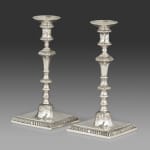Pair of 18th Century Chinese Export Paktong Candlesticks
CHINA, CIRCA 1760-70
25.1 x 11.7 cm
10 x 4 ¾ in
10 x 4 ¾ in
7018
Further images
Pair of Paktong candlesticks made in China for the English market, each cast in two sections with separate bobeches, the square section stem with cut corners, with circular socket and...
Pair of Paktong candlesticks made in China for the English market, each cast in two sections with separate bobeches, the square section stem with cut corners, with circular socket and lower knops. Each of the square gadrooned bases with pseudo hallmarks. Interesting casting imperfection to the stem of one of the candlesticks.
Eloy Koldeweij illustrates a pair of paktong candlesticks of similar form in 'The English Candlestick 1425–1925', (Christie’s Books Ltd.), 2001 cat. 156, p. 169.
In 'Fire and Light in the home, pre-1820', John Caspall illustrates a variety of forms of candlestick from the 14th to the 18th centuries showing dates for the earliest hallmarks applicable to each form. An illustration almost identical to the form of these candlesticks is dated 1756. (Antique Collectors' Club, 2000, p. 105, Plate 2, no. 4.)
A pair of similar form are also illustrated on the cover of Keith Pinn's book 'Paktong - The Chinese Alloy in Europe 1680-1820', Antique Collectors' Club, 1999) and on p. 92, pl. 51.
Paktong is a scarce Chinese alloy combining copper, zinc and nickel; the last, giving it its sought-after bright silver colour, was not identified in the west until the second half of the 18th century. Paktong was imported in small quantities during the 18th century and was used by European craftsmen to make domestic objects which imitated silverware.
Eloy Koldeweij illustrates a pair of paktong candlesticks of similar form in 'The English Candlestick 1425–1925', (Christie’s Books Ltd.), 2001 cat. 156, p. 169.
In 'Fire and Light in the home, pre-1820', John Caspall illustrates a variety of forms of candlestick from the 14th to the 18th centuries showing dates for the earliest hallmarks applicable to each form. An illustration almost identical to the form of these candlesticks is dated 1756. (Antique Collectors' Club, 2000, p. 105, Plate 2, no. 4.)
A pair of similar form are also illustrated on the cover of Keith Pinn's book 'Paktong - The Chinese Alloy in Europe 1680-1820', Antique Collectors' Club, 1999) and on p. 92, pl. 51.
Paktong is a scarce Chinese alloy combining copper, zinc and nickel; the last, giving it its sought-after bright silver colour, was not identified in the west until the second half of the 18th century. Paktong was imported in small quantities during the 18th century and was used by European craftsmen to make domestic objects which imitated silverware.








